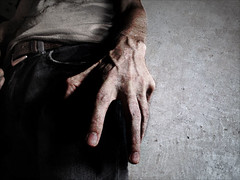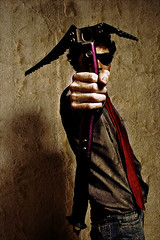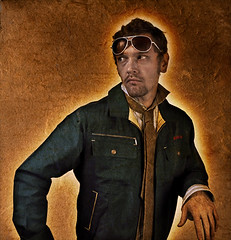Editor’s Note:
The following is a collection of thoughts on Digital Style, an elusive element of Digital Imaging, an extension of Photography.? The author has already admitted during our last project meeting that he “has” no style, nor any particular story to tell – which made him the logical choice for this article.? This is a Style piece, and logic therefore need not apply.
Photoshop is a great big beautiful doorway to the realization of any creative genius that the Devil can conjure up.? For a generation of digital-born image makers it’s the go-to in creating a digital style – that illusive look that sets one image apart from another and defines the distinctive qualities of an Artist.
Millions of poor fools are locked in the cult-mindset that their crap photos can be saved by the Photoshop high Priest-magic of our time – the Photoshop Action.? Load a photo, run the action, Photoshop does all the changes to your image – and there is your masterpiece.? The object of their obsession is getting “the so-and-so look” the high dynamic range of Dragan, the cartoon-like softness of Dave Hill, the gritty power of Joey Lawrence, or even the emotionally engaging elements of Jill Greenberg.
Photoshop, like any unchecked religious fascination quickly becomes a short-cut to thinking if the “program” is placed before the “story.”? Some would say it’s all down to plot and the story line.? Most everything worth reading, watching or looking at has it.? You check out a photograph and there’s a message, something there, a story that pops into your mind and pulls you in.? If there’s no story in your photos, no amount of demon-inspired-bastard Photoshopping will save your blunder.
You can spend hours searching for a top-notch Dave Hill action script, or you can spend about 30 minutes on Strobist, StudioLighting.net, FlashFlavor, and any number of free-learning websites where a sheep can shave the wool from their vision and learn to use light to paint a story on a digital imaging sensor.? Photoshop can enhance and manipulate, but it’s not a creativity creation machine – and it doesn’t need to be.? Creativity is just the Artistic neighbor of Quantum Physics, terms used to things which are not fully understood by the people who use them.
The simple truth is that there’s no secret to Jill’s emotionally charged images or Joey’s gritty grung work.? Lighting and subject, with Dave and Jill and Joey, they are awesome.? Awesome subjects and lighting.? Sure you can imitate Jill’s style, just call up Gwen Stefani or your local bear handler and set up a shoot.? Get the lighting right and you can copy her look. No Photoshop action needed.
“No, no, I got it, Jill and Dave use RING LIGHTS.”
It’s true, many photographers such as Jill G and Dave Hill make sensible use of right light flash heads, but dropping $400 on an Alien Bees head won’t make your images “good” if you have no story to tell.
The limited edition White Stripes Meg Diana with ring light accessory is a different story.? If you drop $180 on this cool camera you’ll space-jump to Hollywood lighting pimp in the span of 5 seconds.
4…3…2…1…take off
Seriously, if you’re looking for digital style – quit Photoshop.? There’s no point in wasting time with the program if you haven’t a clue what look you want or what the story should be.? Take a walk, pick up a Japanese ink pen, build a house of cards, and come back when you have something to say.
The story doesn’t have to be anything special, profound or engaging, but if you simply manipulate your photos in Photoshop trying for that special look and post photos to Flickr messages boards looking for accolades from the web community, your sheep mind will never rise above the level of a second-rate snap shooter.? But is doesn’t have to be, it’s cool just using new tools to be Creative.? However, with new tools comes confusion, consider leaving the digital sanctuary, turn your back on the Photoshop cult and tell your story as it exists in your mind.
Of course, if you have no desire to – keep doing what you were doing.
Trust me, I’m a scientist.
Excellent Photographers:
Jill Greenberg
Joey Lawrence
Dave Hill
Michael Grecco
Andrzej Dragan
Further reading:
A drawn-out Flickr discussion – the Dave Hill Look
A useful Flickr discussion – the Joey Lawrence Look



